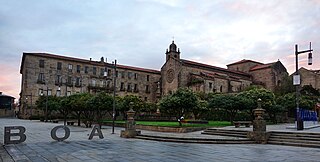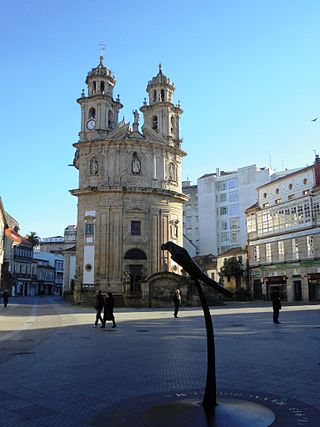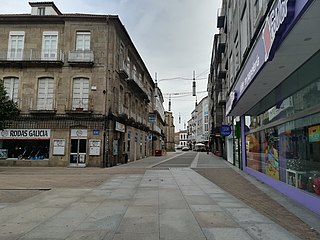
The Valle-Inclán High School is a large eclectic and Art Nouveau building located in the city centre of Pontevedra, Spain. It is named after the writer Valle-Inclán who studied and lived in Pontevedra. Today it is the seat of the Valle-Inclán Secondary School and was the first and the only secondary school in the province of Pontevedra from 1845 to 1927.

The Plaza de la Leña is a picturesque medieval square located in the heart of the old town of Pontevedra (Spain). It is the most typical medieval square in the historic centre and in Galicia.

The Praza da Ferrería is a large square located on the edge of the old town of Pontevedra (Spain), inside the old city walls. It is the main square of the old town and has an area of about 2,000 m2. It includes the small squares of the Estrella on the north side, the Orense square on the south side and the Casto Sampedro square on the east side, making a total of almost 5,000 m2.

The Principal Theatre of Pontevedra (Teatro Principal de Pontevedra) is a theatre in the old town of Pontevedra (Spain).

Valle-Inclán, is a sculpture created by the Spanish sculptor César Lombera, located in Pontevedra (Spain). It is located in Plaza Méndez Núñez and was inaugurated on 26 June 2003.

The building of the former Pontevedra Normal School of Pontevedra, in Pontevedra, Spain, is an eclectic building from the end of the 19th century that was the headquarters of the teacher training college of this Galician city. It is located on the Gran Vía de Montero Ríos, between the Alameda de Pontevedra and the Palm Trees Park.

The Plaza de Teucro is a square of medieval origin located in the heart of the old town of Pontevedra (Spain). It is the most harmoniously proportioned medieval square in the city.

The Plaza de la Verdura is a square of medieval origin located in the heart of the historic centre of Pontevedra (Spain). It is one of the liveliest medieval squares in the city.

Méndez Núñez Square is a square of medieval origin located in the heart of the historic centre of Pontevedra (Spain).

The Plaza de la Pedreira or Plaza de Mugartegui is a square of medieval origin located in the northern part of the old town of Pontevedra (Spain).

The Convent of St. Francis is a Franciscan convent located in the city centre of Pontevedra (Spain), overlooking the Plaza de la Herrería. The Gothic church of San Francis is attached to the convent on the southeast side.

The Plaza de la Peregrina is an 18th-century square located in the city centre of Pontevedra (Spain), on the edge of the historic centre.

The Plaza de España is a 19th century pedestrian square located in the city centre of Pontevedra (Spain), on the edge of the old town and the Alameda de Pontevedra.

Curros Enríquez Square is a square of medieval origin located in the heart of the historic centre of Pontevedra (Spain), on the Portuguese pilgrimage way.

The Chapel of the Nazarene is a Catholic religious building, with the status of chapel, located in the old town of Pontevedra (Spain), in Duque de Tetuán Street, opposite the Principal Theatre.

St. Joseph's Square is a 19th century square located in the centre of the city of Pontevedra (Spain), in the first urban expansion area, near the Campolongo neighbourhood.

The Plaza del Muelle or Praza do Peirao is a square of medieval origin located at the northern edge of the historic centre of Pontevedra (Spain), very close to the Burgo Bridge and the old port neighbourhood A Moureira.

Alonso de Fonseca Square is a medieval square located in the historic centre of the city of Pontevedra (Spain), opposite the Basilica of Saint Mary Major.

The Marquis of Riestra street is a central street in the Spanish city of Pontevedra, in the first expansion zone of the city in the 19th century, running longitudinally parallel to the Palm Trees Park on its eastern side. It is one of the main streets in Pontevedra city centre.

Calle Sarmiento is a street in the Spanish city of Pontevedra, located in the city's historic centre.




























